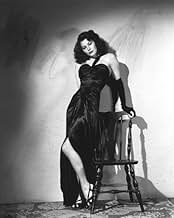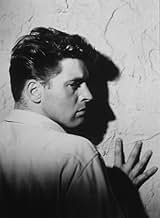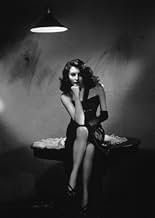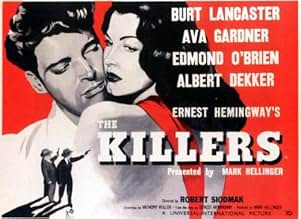Unos sicarios matan a una víctima que no se resiste, y el investigador Reardon descubre su relación pasada con la bella y mortal Kitty Collins.Unos sicarios matan a una víctima que no se resiste, y el investigador Reardon descubre su relación pasada con la bella y mortal Kitty Collins.Unos sicarios matan a una víctima que no se resiste, y el investigador Reardon descubre su relación pasada con la bella y mortal Kitty Collins.
- Dirección
- Guión
- Reparto principal
- Nominado para 4 premios Óscar
- 4 premios y 4 nominaciones en total
- Hood with Cane
- (sin acreditar)
- Assistant Paymaster
- (sin acreditar)
- Jail Ward Doctor
- (sin acreditar)
- Fight Spectator
- (sin acreditar)
- Party Guest
- (sin acreditar)
Reseñas destacadas
Robert Siodmak's classic thriller, along with "Criss Cross" are two of his best pieces of work, proof positive that crime dramas could rise above the mundane and the clichéd.
Based on one of Hemingway's Nick Adams short stories, it tells the intriguing tale of two hit men who show up in a small town (the film moves it from the Midwest to New Jersey), where they take over a diner and tell its terrified occupants they intend to murder a nobody of a gas station attendant when he comes in for dinner. When he doesn't show, they hunt him down at the rooming house where he lives and do the job there. That's where the short story ends, but the script by Anthony Veiller picks it up from there, pursuing the fascinating story of what makes a man give up on life to the point where he passively waits for a pair of gunmen to show up and blow him to smithereens.
The protagonist,called the Swede, is a guy who isn't a criminal by nature, just a guy who fell upon hard times, but sees a way out by committing one more crime. And of course, as in any good film noir, his greed is fueled more by lust than anything else. There's a girl involved and in order to get her, he has to get the loot.
Burt Lancaster, in his first staring role, comes off very well here, as does Ava Gardner, also top billed for the first time. Strong supporting performances by the great Albert Dekker as the top hood and Sam Levine as a cop with a heart of gold. And we cannot forget Charles McGraw and William Conrad as two of the most frightening cold blooded killers in film history.
Siodmak does a great job in the director's chair in this Mark Hellinger (The Roaring Twenties) produced drama, but it is cinematographer Woody Bredell who steals the show. His use of lighting goes beyond spectacular. All of the clichés we think of in film noir lighting spring from this one film, where they were done right. And watch for one of the longest tracking shots in film history, as Nick Adams flees the diner and races to the Swede's rooming house to warn him. It's an amazing, unbroken shot that runs more than a minute.
Watch, too, for the brilliant shoot 'em up scene in a restaurant at the end of the movie when the two gunmen reappear. It is just a textbook blend of all the movies are supposed to be about, great acting, camera movement that means something, and brilliantly layered music by Miklos Rozsa. Film-making doesn't get any better than this.
A four star film and one of the godfathers of the genre. Don't miss this one.
'The Killers' begins with two hit men arriving in a small town with only one objective: kill 'Swede' Anderson (Burt Lancaster). After this, a detective starts to investigate his death, by interviewing the people of the town. This is how he uncovers a murderous plot evolving multiple characters. This is one of those movies that really keeps you interesting and anxious on what's going to happen, ans when the plot reveals itself, it's really awesome how everything is around Kitty Collins (Ava Gardner). The story is well-told and aged really well.
The acting here is not superb, but it's not bad also. The movie is important because it's the first major role of Burt Lancaster, and the movie made him a star. It also features the always beautiful and mysterious Ava Gardner and the competent Edward O'Brien, in a interesting role.
I have never watched a Robert Siodmak picture before, and was surprised to see how well he directed this picture. The camera was always at an interesting and different angle, and there's one nice tracking shot in the middle of the movie. Along with the well-made soundtrack by Miklós Rózsa, and the also well-made cinematography by Elwood Bredell the mood in here couldn't be better.
Overral, this is a great film-noir movie, one of the best of its genre. It aged really well, most because of Ernest Hemingway's powerful story. It keeps you interested, with nice acting and directing.
8/10
Also, get a load of that opening scene—a midnight diner, shadowy figures, an empty street. Noir seldom comes any purer. All that's missing is a lonely train whistle. In fact, I'll take that extended scene as the movie's best. McGraw and Conrad drop enough tough talk on the poor counterman to drown the average fall guy. It's from that tense 15-minutes that the movie gets what grit it has. The story's remainder is more like a metaphysical puzzle, as Reardon tries to piece together a solution to Swede's mysterious death. Trouble is he's got to rely on second-hand sources since Swede's in no condition to talk. Plus the sources from his past are disconnected in the telling, so it's like trying to figure out a jigsaw. Then too, will the pieces all fit since somebody could be lying—maybe the squinty Dumb-Dumb or the cringing Charleston, or even the curiously laid-back Colfax (Dekker).
This is a narrative you have to think about once it's over. Because, like a highway under construction, there're a lot of twists and turns. Curiously, the main part is largely devoid of action or even much violence. Instead, the writers and director Siodmak settle for atmospheric exposition, and I'm not sure if that helps or hinders. But either way, the unraveling is compelling. Then too, that final scene on the staircase is oddly reminiscent— in this case, Mary Astor's elevator going down at the end of The Maltese Falcon (1941) despite her emotional pleas.
Anyway, 40's noir hardly comes any purer, from spider woman to fall guy to $50 lighting bill. So if you don't mind a complex plot-line, this is one to catch.
'The Killers' opens with a thrilling prologue that sees two hired thugs (William Conrad and B-noir stalwart Charles McGraw) harass the patrons at a small-town diner on their way to assassinate Swede Andersen. The characters' quickfire exchange of dialogue resembles something that Tarantino or the Coen brothers would have written decades later, only better, because screenwriter Anthony Veiller (with Richard Brooks and John Huston) reproduces the conversation from Hemingway's short story almost verbatim. After Andersen is unresistingly gunned down in his bed, the screenplay then expands upon the foundations laid down by the source material, using flashbacks to fill in the empty spaces at which Hemingway had only hinted. Veiller, whose work before WWII was dominated by romantic dramas, comedies and light mysteries like 'The Ex-Mrs. Bradford (1936),' appears to have been hardened by his work on Frank Capra's "Why We Fight" propaganda series, and the dark, cynical post-War tone he brings to Swede's tragic story is an ideal representation of the noir spirit.
Burt Lancaster shows promise in his screen debut, though the film's narrative structure does keep the audience distant from his character, an issue that Welles somehow avoided in 'Citizen Kane.' As the resident femme fatale, Ava Gardner never quite inspires the collective hatred garnered by Barbara Stanwyck in 'Double Indemnity (1944)' or Jane Greer in 'Out of the Past (1947),' but perhaps that speaks to her charms – that, despite her betrayal, we're still unwilling to treat her with due contempt. Good-guy Edmond O'Brien cheerfully and voyeuristically experiences the wretched life of a gangster through the intermediary flashback device – he ends the film with a cocky grin, like an audience-member emerging from a screening of the latest gangster thriller. Throughout this review, I've been making allusions to 'Citizen Kane,' but there's a very important difference between the two main characters: Charles Foster Kane had all the money in the world and got nothing out of it. Swede Andersen wasn't even that lucky; he didn't even get the money.
¿Sabías que...?
- CuriosidadesFilm debut of Burt Lancaster. Although this was his first film--at 33 years of age--he received top billing.
- PifiasIn the jailhouse, Charleston (Vince Barnett) tells The Swede (Burt Lancaster) of his love for the stars. As he looks out the window, he says that he says he sees Orion and a prominent star, Betelgeuse. He says that Orion is the "Great Bear" and that Betelgeuse is the "brightest star in the sky". Orion is actually The Hunter. Ursa Major (containing the Big Dipper) is the Great Bear. Betelgeuse, while quite bright, is the 10th brightest star.
- Citas
[last lines]
[after Reardon has wrapped up the investigation, Kenyon congratulates him]
R.S. Kenyon: Owing to your splendid efforts the basic rate of The Atlantic Casualty Company - as of 1947 - will probably drop one-tenth of a cent.
[he shakes Reardon's hand]
R.S. Kenyon: Congratulations, Mr. Reardon.
Jim Reardon: I'd rather have a night's sleep.
R.S. Kenyon: Why don't you take a good rest. I must say you've earned it.
[Reardon starts to leave]
R.S. Kenyon: This is Friday... don't come in 'til Monday.
Jim Reardon: Thanks.
- ConexionesEdited into Cliente muerto no paga (1982)
- Banda sonoraThe More I Know of Love
(1946)
Music by Miklós Rózsa
Lyrics Jack Brooks
Performed by Ava Gardner (uncredited)
Selecciones populares
Detalles
- Fecha de lanzamiento
- País de origen
- Sitio oficial
- Idioma
- Títulos en diferentes países
- Los asesinos
- Localizaciones del rodaje
- Empresas productoras
- Ver más compañías en los créditos en IMDbPro
Taquilla
- Recaudación en todo el mundo
- 58.222 US$
- Duración1 hora 43 minutos
- Color
- Relación de aspecto
- 1.37 : 1






































